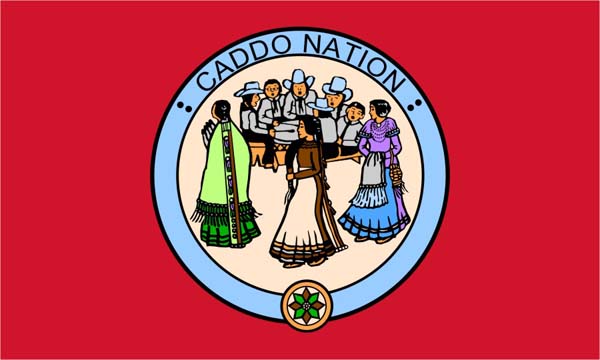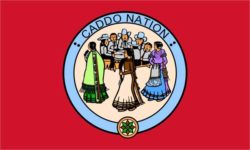Caddo Indian Treaty
The Caddo Indian Treaty of 1835 between the Caddo people of northwestern Louisiana and the US government resulted in a protected American boundary with Mexico, the relocation of the Caddo from Louisiana to Indian Territory (now Oklahoma), and the establishment of present-day Shreveport.

Courtesy of Wikimedia Commons
Flag of the Caddo Nation. Caddo Nation; rendering by Wikimedia Commons user Walden
The city of Shreveport and much of the northwestern corner of Louisiana sit on land acquired by the United States under the terms of the Caddo Indian Treaty of 1835. Caddo villages are known to have been located throughout the area, and it is from these indigenous peoples that the name of Caddo Parish, of which Shreveport is the seat of government, is taken.
In March 1835 Colonel Jehiel Brooks received instructions from the US government to negotiate a treaty with the Caddo people of northwestern Louisiana for their land. The acquisition was intended to permanently establish and protect the boundary between the United States and Mexico, the latter of which then extended to the current Louisiana-Texas state line.
Official reports estimated that Caddo lands contained somewhere between six hundred thousand and one million acres of property. Some historians have claimed that the Caddo desired to move elsewhere due to a declining game population, but this is questionable. Considering the importance of tribal sovereignty and the possible threat of losing their land by force without a treaty, the Caddo likely saw cessation as their only viable response to the United States’ request.
Negotiation
Larkin Edwards, an interpreter for the Caddo and the Anglo-American husband of a Caddo princess, visited various villages and assembled 489 of the Caddo at the agency house, in the vicinity of what became Shreveport, to select a council to listen to and negotiate the terms of a proposed treaty. On June 26, 1835, head chief Tarshar, underchief Tsauninot, and twenty-three councilors listened, via the interpreter Edwards, to Col. Brooks state the US government’s intentions.
Brooks told the Caddo that President Andrew Jackson desired to buy Caddo land and relocate its people to new, unopened territory. (Five years earlier President Jackson had signed the Indian Removal Act into law, forcibly relocating tribes west of the Mississippi River and causing the deaths of tens of thousands of Native Americans.) Although the Caddo initially opposed leaving their homeland, Tarshar made an eloquent speech persuading his people that moving to lands with more game and fewer white settlers might be the best option available. Ultimately, the Caddo agreed.
Notably, Brooks negotiated the terms of the treaty to include two 640-acre reserves of land—one for Edwards and another for a deceased French settler, François Grappe. Although Brooks stated formally that the Caddo requested the reserve for Grappe, historical evidence indicates that the reserve was Brooks’s doing and that the Caddo had no role in it. Moreover, the Caddo had no knowledge of who Grappe was. As it turned out, Brooks later purchased the reserve from the Grappe family for himself at a fraction of its value. This real-estate scheme appears to have been his plan all along.
Treaty Terms
In any case, the treaty came to pass. Under its terms, the Caddo would release all tribal lands to the United States. This territory included land from the line of the Arkansas Territory, south along the Red River to Pascagoula Bayou, west along the Bayou to Wallace Lake, across the lake to Cypress Bayou, and up to the US-Mexico border, then northward along that border to Arkansas again. This area encompassed roughly the whole of modern Caddo Parish and a portion of DeSoto Parish as well. Article Two of the treaty stated that the Caddo “do voluntarily relinquish their possession to the territory of land aforesaid and promise to remove, at their own expense, out of the boundaries of the United States and the territories belonging and appertaining thereto within the period of one year from and after the signing of this treaty and never more return to live, settle, or establish themselves as a nation, tribe, or community of people within the same.”
As compensation the Caddo received $80,000 in goods and horses, plus $50,000 in specie paid with $10,000 down and $10,000 per year over the next four years. John W. Edwards, Larkin’s half-Caddo son, translated the treaty into the Caddo language. After each member of the council made his mark upon the instrument of treaty, the council pipe was passed about and congratulations were exchanged.
Outcome
Within the year, the Caddo migrated from northwest Louisiana to the Indian territory to the northwest. That land, now called Oklahoma, is home to most of the remaining Caddo Nation, only a handful of whom still speak the Caddo language.
Brooks was greatly enriched via his real-estate machinations, and the land transfer made way, shortly afterward, for theestablishment of Shreve Town, later to be called Shreveport. The treaty was ratified by the US Senate on January 26, 1836, and signed by President Jackson on February 2, 1836.
